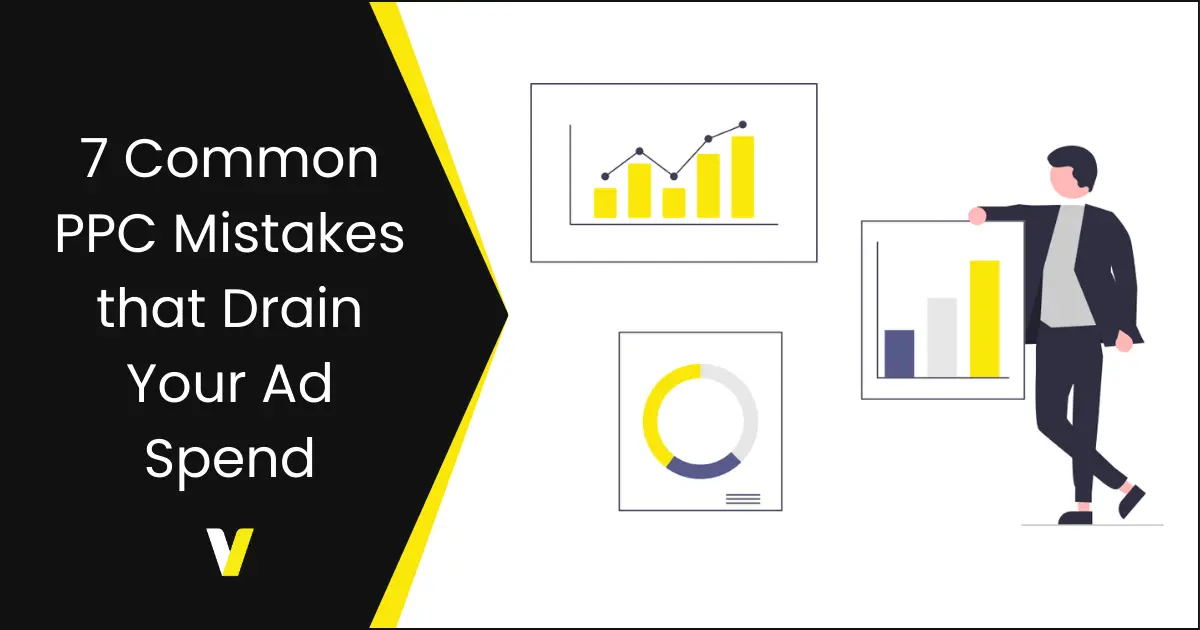Pay-per-click (PPC) advertising is one of the best ways in digital marketing to reach the target audience and drive sales. Businesses of all sizes can utilize this market channel to bring in more customers, and website traffic, and generate a tremendous amount of revenue. But there is a thing about PPC. It will perform well only if you manage things properly. If you ignore certain aspects of PPC, it may drain your ad spend by driving irrelevant clicks and traffic, impacting your quality score, etc.
To make the most of your PPC advertising campaigns, you need to ensure that you are avoiding some common mistakes. In this write-up, let’s learn about these mistakes and the right ways to fix them. Avoiding these mistakes can help you save a massive amount every month. So, let’s move to the list of common Google ad mistakes made by webmasters and marketers.

Improper Targeting
If you don’t target the audience appropriately, your advertisement will be shown to the wrong audience. If the people who see your ad have nothing to do with it, you have failed to create the right ad. It will just decline your click-through rate (CTR) and waste your money.
Fortunately, you can fix this PPC mistake by understanding how to target your audience the right way. The first thing to do is find exactly who your customers are by creating a buyer persona. Here, you have to note down certain things related to your audience, including their age, occupation, fears, interests, etc.
A buyer persona will help you create the right target audience in PPC and improve your marketing strategy.
Ineffective Ad Copy
Ad copy is the title, description, and other text that you use in your ad. The CTR of an ad depends significantly on the ad copy. If you are creating an ad campaign for the first time, it might be a bit difficult to write a compelling ad copy. But there are certain ways to improve it.
The first way is to analyze the ads of your competitors. For instance, search for your keyword and see the ads of other websites. Then, analyze their strategy and content. Moreover, when you see a display ad anywhere and feel like clicking it, then take a screenshot of such copies for reference.
While writing the content for your ad, you must keep in mind the objectives of your audience. In the headline, try to include numbers and emotional triggers. Next, ensure that your keyword is part of the content. Lastly, write multiple ad copies to find which one works the best for you.
Not split testing
With the split testing feature, you can use the data and technology for your benefits. The role of this feature is to help you understand what sort of ad will perform the best for a specific campaign. You don’t need to rely only on your instincts when there is a split testing option to save you money and time.
If you are not using it, then it is one of the biggest PPC mistakes. Doing split testing can help you to boost the conversion rate.
The proper way to do it is to create multiple variations of a single ad by changing one or two aspects of it. Then analyze the changes in the performance of the ad. With this, you can finalize the ad to go ahead with.
Lack Of Message Continuity
It is among the most common Google ad mistakes made by marketers and webmasters. Lack of message continuity means that you have a specific message on your ad copy, but when the user clicks the ad and reaches the landing page, the message is different there.
For example, you are running a Black Friday offer through an ad, but you haven’t updated the landing page with any information about the offer. As a result, the audience will get confused and abandon the website rather than converting.
Neglecting Landing Page Quality
Many marketers focus too much on creating ad campaigns that they forget the importance of landing page quality. When you run Google Ads, it calculates the quality of your landing page and assigns a score. This score depends on the quality of content, loading time for mobile and desktop devices, and relevance.
If your page quality score is poor, you will pay more bidding score for the keywords than your competitors. Moreover, if your landing page doesn’t load instantly, the users who visit it after clicking the ad will abandon it. The ads will prove to be useless.
Setting and Forgetting It
When you have created and run a PPC campaign, it is crucial to keep track of it regularly. For better performance, monitoring is important. If you are someone who has focused on creating the ad and don’t monitor it on a regular basis, then you may sometimes spend more ad budget.
Monitoring doesn’t take much time. You can quickly access and view the important metrics like CPC, leads generated, return on ad spend (ROAS), conversion rate, etc.
Trying To Scale Up Too Quickly
When the performance of an ad is good, most of the marketers and webmasters increase the ad spend quickly. In addition, they try to scale up by adding more budget to the ad. However, in many cases, it can result in disturbing your momentum. This happens because the algorithm finds it challenging to find suitable placements for your ad when there are massive changes in the budget.
It is one of the most common pay-per-click mistakes that you can avoid by increasing the ad spend or budget only by 20% every day.
Wrapping Up
PPC campaigns have the potential to bring your business new customers and revenue growth. But you need to avoid the common Google ad mistakes mentioned above in the article. These mistakes can drain your ad budget and result in losing your revenue rather than increasing it.
For any other doubts or questions related to PPC campaigns, let us know using the comments below.
Ashwdeep, is a Founder & Chief Mentor of the Ventureheap Academy having 10+ years of experience in the Digital Marketing domain. His core area of practice is Search Algorithms which has given him an edge in analytical thinking with a unique perspective. He has worked as a digital marketing consultant with 300+ brands across 19 countries. He has a rich experience of writing in different areas related to marketing, technology & businesses.

Categories
- Digital Marketing (12)
- Digital Marketing Institutes (58)
- Paid Ads (3)
- SEO (5)
- Social Media (1)
- Website Development (1)
Recent Posts
- Digital Marketing Courses in Ernakulam March 4, 2024
- Digital Marketing courses in Coimbatore March 1, 2024
- Digital marketing courses in Thrissur February 28, 2024








